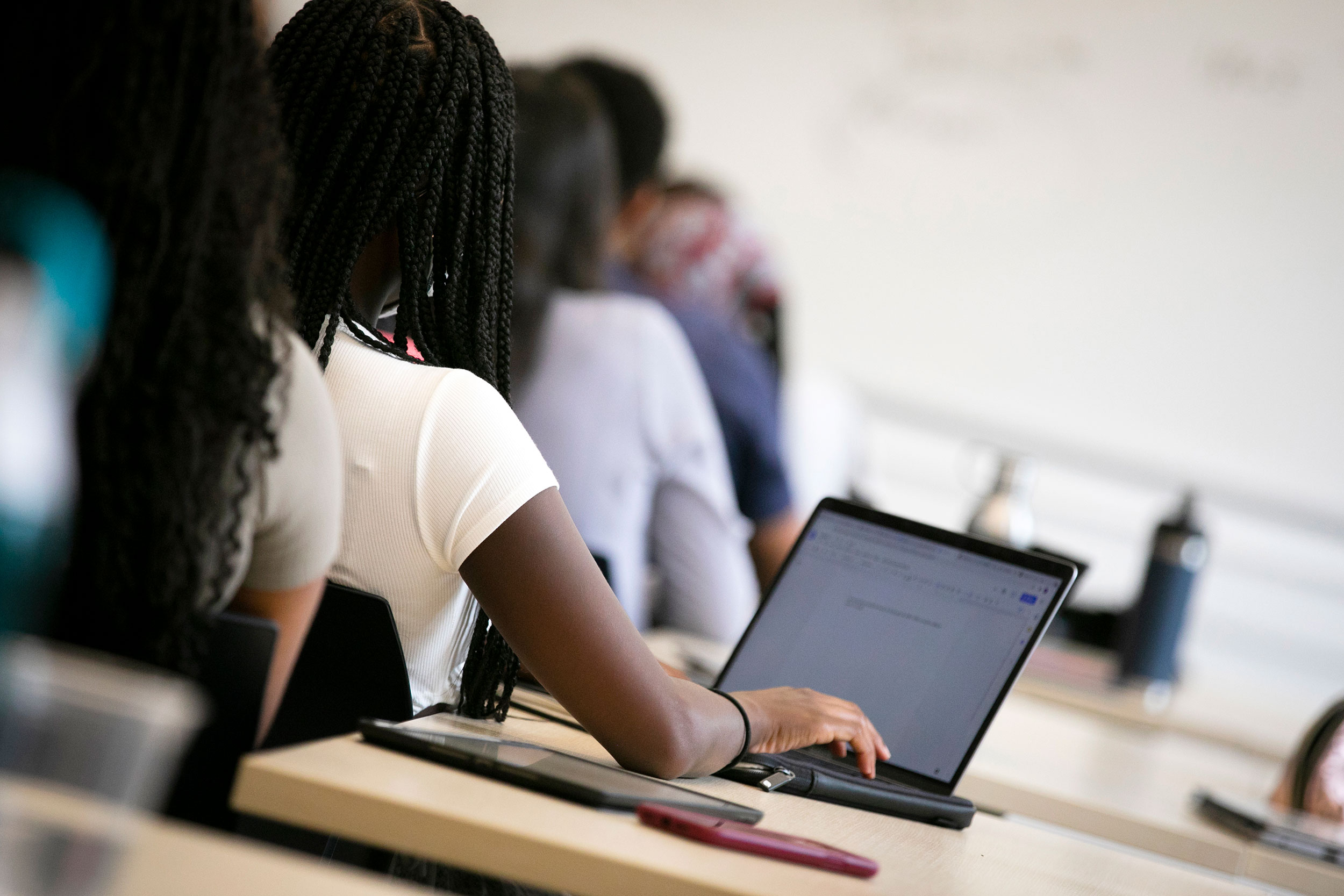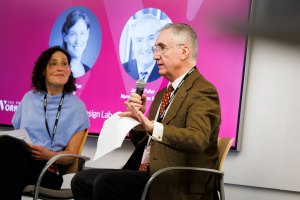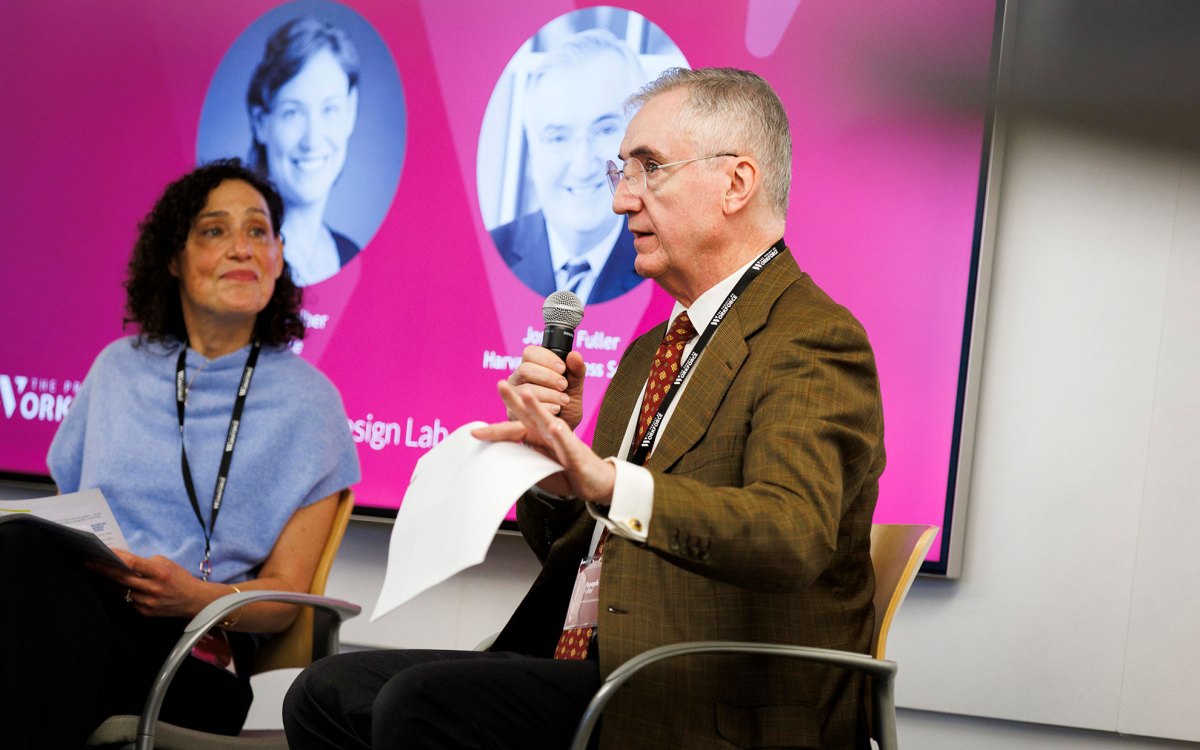
Teaching remotely offered new opportunities, some of which could prove successful in the return to in-person learning.
Stephanie Mitchell/Harvard Staff Photographer
Finding hands-on approaches to remote learning
‘Active learning’ helps students learn better by engaging them physically
Mention a college classroom, and most people picture a big hall packed with students listening to a professor lecture. It’s a tried-and-true way of teaching, but is it the best for student learning? Growing evidence has shown that techniques that get students to participate in the learning process — from answering clicker questions to working in groups — produce better educational outcomes at virtually all levels.
An influential 2019 Harvard study showed that when it comes to active learning, students might be taking in more than they think they are. It found that while students felt as if they learned more through well-presented traditional lectures, they actually learned more when taking part in classrooms that employed the active strategies.
Science magazine recently assembled several small teams of experts in active learning and asked them for an overview of best practices that can inform the return to in-person teaching. Three authors from the Harvard study — Louis Deslauriers, director of science teaching and learning in Faculty of Arts and Sciences; Logan McCarty, director of sciences education in FAS; and Kristina Callaghan, a former Harvard graduate student and now physics lecturer at the University of California, Merced — offered theirs. The Gazette spoke to Deslauriers and McCarty about what can be taken going forward. This interview was edited for length and clarity.
Q&A
Louis Deslauriers and Logan McCarty
GAZETTE: In this new Science article, you revisit that 2019 study. Is this work just as timely now as it was when it first came out?
McCARTY: I think it’s even more timely. We’ve seen that we don’t have to keep teaching the way we always used to. We’ve just had 18 months of everyone teaching in a completely different way. The argument that “I should keep lecturing because I’ve always lectured and that’s always been fine” is no longer a good argument. We’re at a point post-remote learning where we should be asking: What are the lessons that we learned from this period that we can apply to our in-person learning? Being informed by research like this is so important. We have an opportunity to set a new bar, new expectations for what education should be. The articles in this Science collection are amazing little vignettes that can inform how we teach. I loved the “Physically Active Learning” article by Dan Schwartz [an education professor at Stanford]. It explains that physical movements can help students solve difficult problems, generate new ideas, and think more creatively. It shows how far active learning research has come and how much of an impact it can have in the classroom.
GAZETTE: With the pandemic and so many schools moving to remote learning, what happened in terms of active learning?
DESLAURIERS: Consensus is that COVID and remote learning has had a mixed effect on advancing the use of research-based pedagogies in classrooms. Many traditional instructors who were horrified in March 2020 and who later used active learning have had moderate or OK experiences. Given the circumstances, I would call these success cases. Many others tried active learning for the first time and have had terrible experiences. Unfortunately, it’s a bit of a mixed bag. However, the net positive is that the experience has had everyone thinking and talking about teaching and learning. Our study addresses a cognitive dissonance for faculty members who remember learning a lot from great lecturers. I think our study is helping change the culture surrounding great lectures.
McCARTY: The pandemic basically forced faculty to start adopting techniques of active learning that they had been hesitant to use. Instructors realized almost right away that just giving lectures over Zoom was not going to work. Even short lectures, like 10 minutes, are difficult to absorb unless the students are really primed for what they will hear. A 75-minute lecture on Zoom is intolerable. The spring of 2020 was such an illustration of that. Over the summer, as many instructors prepared for the fall, the talk was: What do we have to do differently? A lot of the techniques were about keeping students engaged. That meant using breakout rooms, using polling, using the chat effectively during class. These are all analogous to techniques that faculty can use during active learning in-person. My hope is they’ll keep doing that back in the classroom.
GAZETTE: What were some common difficulties of active learning online?
DESLAURIERS: Successfully implementing active learning can sometimes be difficult for instructors. When you’re online, the difficulty level goes up. For instance, while research shows the critical importance of having students interact and learn from each other, it is not so simple to do so online. One of the most common struggles was with break-out rooms. If not set up well, students complain that they find themselves in a breakout room just looking at each other and not really interacting productively. Making it work required some planning, like providing students with clear instructions about what you expect them to do and having the instructors pop in to help keep conversations going. It’s the digital learning version of what we do in the classroom.
GAZETTE: What are some lessons from the pandemic with active learning or things that people should be more wary of?
DESLAURIERS: There are many, but one is student fatigue. I’m a lot more appreciative of monitoring their fatigue level, which sets their ability to stay engaged. That was never at the forefront for me, but it’s different now. These types of high-intensity active learning methods require students to alternate between working on in-class activities (alone and in groups) and instructor feedback. This process, which repeats for the entire class period, is quite effective, but can be quite tiring for students. Doing this during remote instruction laid bare how quickly they can become fatigued.
McCARTY: Remote teaching really solidified for me that active learning is a cognitive struggle. Active learning feels like an effort and it seemed even more pronounced when doing it online. If you’re doing really effective online active learning, the students should feel like, “Wow, my brain hurts after an hour of doing this because I’ve been really heavily engaged throughout that time.”
Another thing was that faculty became much more flexible with our students in terms of extensions on deadlines or dropping homework assignments, especially after seeing into people’s homes and realizing they come from many backgrounds and home situations. I think we learned that we could be more flexible in those things and people would still learn physics. We don’t have to be so rigid. I would like us to continue being more flexible and more generous. This especially speaks to Louis’ point about just realizing how exhausting it is sometimes for students when they’re doing this heavy learning. Also, given that active learning brings benefits to students from low-income backgrounds and underrepresented groups, using it in our courses can help bridge the equity gap.
GAZETTE: In the article, you recommend instructors take a moment and discuss with their students “notions of learning versus the feeling of learning and persuade students that they are in fact benefiting from the sustained mental efforts associated with active learning.” Has that been successful in your experience?
DESLAURIERS: Indeed it has. Greg Kestin, a preceptor in physics and author on the study, was the first to do this in his course. He did a 20-minute intervention at the very beginning of the semester where he explained the results of this paper to his students. Later, when he surveyed students, he found that this intervention really helped them appreciate that issue of feeling of learning versus actual learning. I always do this now and many instructors at other institutions have written to us letting us know that this type of intervention helped student attitudes in their courses.
GAZETTE: What do you hope readers take away from this forum?
McCARTY: Active learning is not only an incredibly timely area of study, but it’s the subject of serious academic inquiry. It’s based on deep research and can no longer be dismissed as an educational fad.




